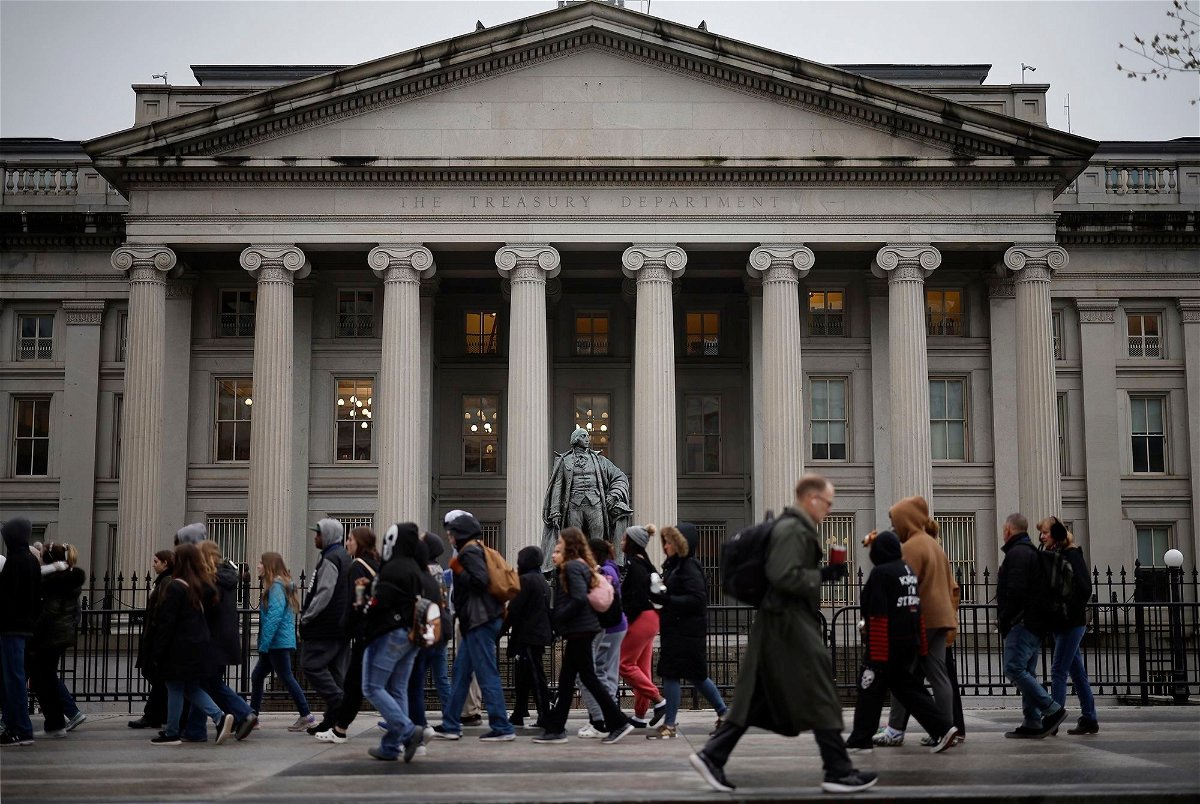America’s debt problem is storing up trouble for the rest of the world

The US Department of Treasury building is seen in March 2023. US government debt is nearing $35 trillion.
London (CNN) — The high and rising level of US government debt risks driving up borrowing costs around the world and undermining global financial stability, the International Monetary Fund has warned.
The IMF said Wednesday that increased government spending, growing public debt and elevated interest rates in the United States had contributed to high and volatile yields — or interest rates — on Treasuries, raising the risk of higher rates elsewhere.
Its analysis found that a spike in yields on long-term US government bonds is associated with similar surges in government bond yields in other advanced and developing economies, with the latter suffering exchange rate turbulence as well.
“Loose fiscal policy in the United States exerts upward pressure on global interest rates and the dollar,” Vitor Gaspar, director of the IMF’s fiscal affairs department, told reporters. “It pushes up funding costs in the rest of the world, thereby exacerbating existing fragilities and risks.”
It’s the second time this week the IMF has fired a shot across the bows of the US government. On Tuesday, it said public spending and borrowing was contributing to an overheating of the US economy, making it harder for the Federal Reserve to defeat inflation.
Higher interest rates make it more costly for households and businesses to service their loans, which can lead to defaults that cause losses at banks and other lenders, increasing financial instability.
The IMF’s warning will add to concerns about the broader consequences of ballooning US government debt, which the Treasury Department puts at nearly $35 trillion.
On Tuesday, Treasury yields touched fresh highs for the year after Fed chair Jerome Powell signaled that official interest rates could stay high for a while yet because of persistent inflation in the United States.
US consumer prices have been propped up by debt-fueled government spending — including pandemic stimulus — which has boosted households’ spending power and turbocharged economic growth.
Loose US fiscal policy, in addition to increasing the country’s already hefty debt burden, could make “the last mile” of getting inflation back down to the Fed’s target harder to achieve, the IMF said.
The Washington-based agency is also worried that, if US inflation stays high, it could dash investors’ hopes for interest rate cuts, leading to a selloff of financial assets, including stocks and government bonds around the world. A resulting fall in the price of bonds would raise their yields.
“Under this scenario, financial conditions would broadly tighten,” Tobias Adrian, director of the IMF’s monetary and capital markets department, wrote Tuesday in a blog accompanying the agency’s Global Financial Stability Report. “Globally, borrowers would find it harder to service debt, given higher bond yields,” he added.
According to Gaspar, the problem could be especially acute in low-income countries, where constraints on public finances are “particularly severe.” “High and volatile interest rates make the situation worse,” he said.
US debt looks riskier
There are risks for the United States too. According to the IMF, investors are demanding higher returns to hold US Treasuries, reflecting their concerns over sustained inflation, the uncertain future path of monetary policy and additional debt issuance in the world’s biggest economy.
“The risk premium on (US) government debt has increased in recent times and may remain high in a context in which debt levels are elevated,” the agency’s chief economist Pierre-Olivier Gourinchas told reporters Tuesday.
That means that even if the Fed cuts interest rates later this year — the IMF’s central scenario — US government funding costs may not fall by the same margin, he added.
That would place further pressure on the government’s finances, leaving less money for public services or for absorbing future adverse shocks to the economy, such as financial meltdowns, pandemics or wars.
The US government’s interest costs on a common measure soared to $659 billion in fiscal year 2023, which ended on September 30, according to the Treasury Department. That’s nearly double what it was in fiscal year 2020.
And according to the Committee for a Responsible Federal Budget, a non-profit, in fiscal year 2023, the government spent more to service its debt than it did on each of housing, transport and higher education.
The IMF expects US public debt to continue rising, helping drive government debt worldwide to close to 100% of global gross domestic product by 2029, from 93% last year.
The agency called on governments everywhere to exercise “fiscal restraint” in the world’s “biggest-ever election year.”
“History shows governments tend to spend more and tax less during election years,” it said.
The-CNN-Wire
™ & © 2024 Cable News Network, Inc., a Warner Bros. Discovery Company. All rights reserved.


